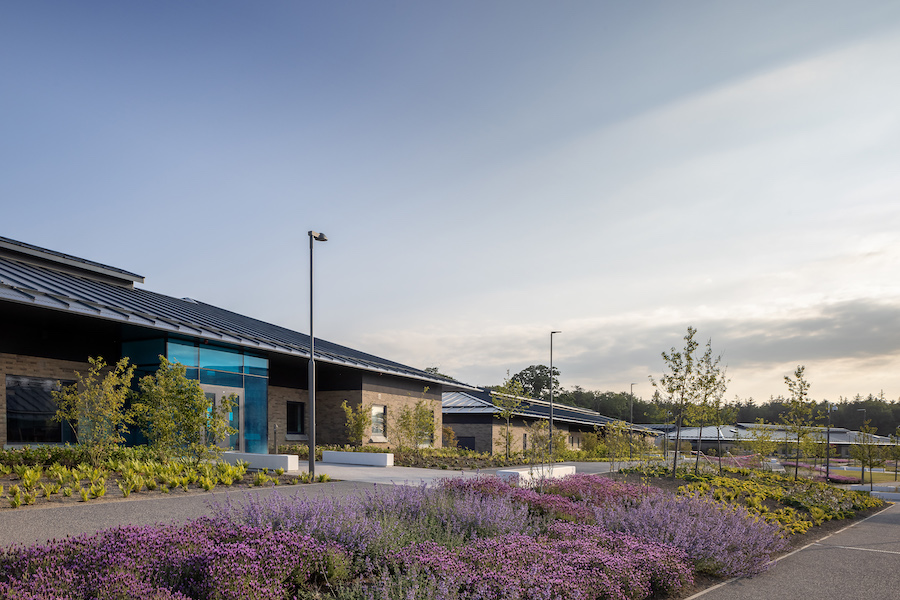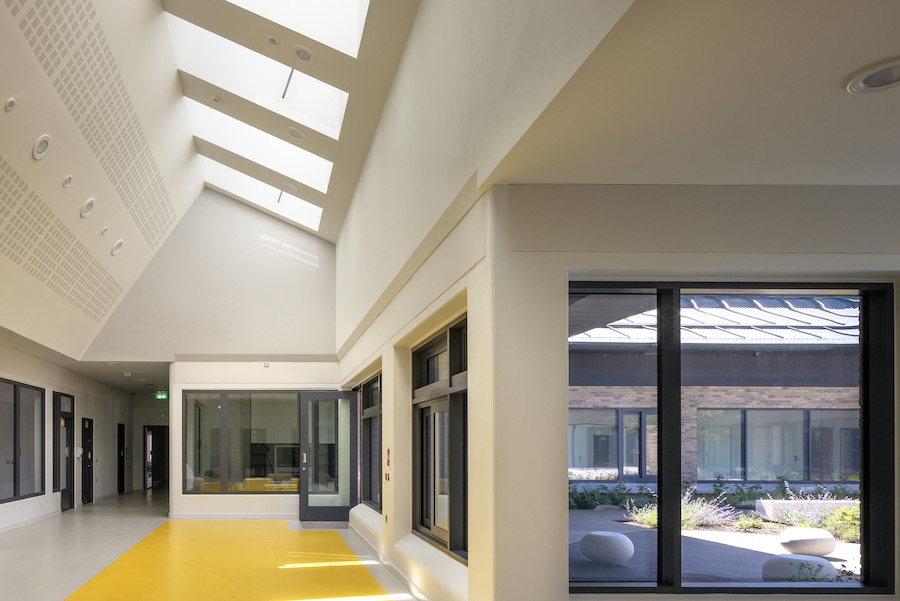Mental/behavioural healthcare / Security
Mental health service to focus on therapeutic care and security with dignity
By Andrew Sansom | 09 Nov 2022 | 0
Heralding a new era in mental health services and forensic mental health in Ireland, the new National Forensic Mental Health Service (NFMHS) has been officially opened by government ministers in Portrane, Co. Dublin.
Minister for Health Stephen Donnelly, Minister of State for Mental Health and Older People Mary Butler, and Minister of State for Public Health, Wellbeing and National Drugs Strategy Frank Feighan, attended the opening, which sees the relocation of the 172-year-old Central Mental Hospital (CMH) in Dundrum to a new state-of-the-art, purpose-built facility north of Dublin.
Designed by Scott Tallon Walker Architects in association with Medical Architecture, the new campus supports the provision of a modern forensic mental health service, and comprises a network of forensic facilities to enable timely intervention.
Situated on a 10-hectare woodland site north of Dublin City, the 24,000m2 campus will accommodate 170 high-, medium-, and low-secure mental health beds. Buildings are strategically placed to optimise the existing topology, mature woodland setting, and long coastal views – contributing to patient recovery.
Speaking at the official opening, Health Minister Stephen Donnelly said: “This fantastic new facility brings real and necessary change to the lives of some of the most vulnerable in our society. This opening reiterates the Government’s commitment that healthcare to this vulnerable group should be delivered on the same values, principles and approaches that apply to all others in society.” 
The NFMHS will provide a national tertiary mental health service, working with local mental health services in every part of Ireland and outreach to prisons/courts for those with high-level mental health difficulties.
Facilities include a new 130-bed CMH; a 30-bed intensive care rehabilitation unit (ICRU); and a ten-bed forensic child and adolescent mental health service (FCAMHS) unit. The NFMHS will also offer five clusters of forensic mental healthcare, including a pre-discharge unit; female unit; mental health intellectual disability unit (MHID‐F); high-secure unit; and a medium-secure unit.
Collective activities and therapies
Single patient bedrooms are laid out in small wards around shared indoor and outdoor spaces, in which collective activities and therapies take place.
In a statement, Scott Tallon Walker Architects said: “The in-patient single-storey pavilion buildings are set around a pedestrianised ‘village green’ with peaceful gardens for patient amenity and activities. Nestled among the in-patient buildings, a ‘village centre’ provides a range of shared recreational facilities, including a horticultural area.”
The village centre also features a gym, a woodwork workshop and a music room, while a series of courtyards and secure perimeter gardens allow patients direct access to nature from each ward.
“Intuitive wayfinding is achieved through a site-wide narrative of colour, art, and landscaping,” added the architects. “At night, illuminated coloured glazed entrances to the various in-patient buildings act as beacons in the woodland setting.”
According to the Irish Government, the new campus will not only increase the number of high- and medium-secure beds in accordance with international comparisons but also support the delivery of specialist secure care and modernise clinical practice.
 Mary Butler, minister for mental health and older people, hailed the facility as “one of the most modern forensic mental health facilities in Europe”, representing “the biggest health capital project ever, outside of the acute general hospital system, with a cost of over €200 million”.
Mary Butler, minister for mental health and older people, hailed the facility as “one of the most modern forensic mental health facilities in Europe”, representing “the biggest health capital project ever, outside of the acute general hospital system, with a cost of over €200 million”.
She added: “Importantly, for people using the service and their families, the new facility will support the enhanced delivery of person-centred care underpinned by human rights. I welcome in particular a designated new female-only unit in line with best national and international practice.”
Integrated care for high-risk drug users
Embodying the key principles of high-secure mental healthcare design, the new facility will also support the underlying roles of therapeutic care and security with dignity.
Frank Feighan, minister for public health and wellbeing, explained how the facility can support this work in practice, in relation to the national drugs strategy.
“People with severe mental health difficulties can also experience addiction issues, referred to as dual diagnosis,” he said. “Improving mental health services for prisoners with dual diagnosis is part of developing integrated care pathways for high-risk drug users, which is a strategic priority in the national drugs strategy.
“I hope the new facility will facilitate a joined-up approach by professionals providing healthcare for prisoners affected by dual diagnosis. There is an opportunity to link this health service with the Health Service Executive dual diagnosis clinical programme, so that prisoners can continue to be supported by specialist mental health services in the community on their release.”
Speaking previously about the project, Medical Architecture director Ruairi Reeves said: “This is the result of a successful ten-year collaboration with Scott Tallon Walker Architects and the project team. We began with a brief for a very large, potentially institutional hospital at 24,500m² and explored how to create a scale that patients would feel they could relate to. The result creates a very real sense of community and enables the service to focus on the patient’s therapeutic programme of recovery.”
Organisations involved



